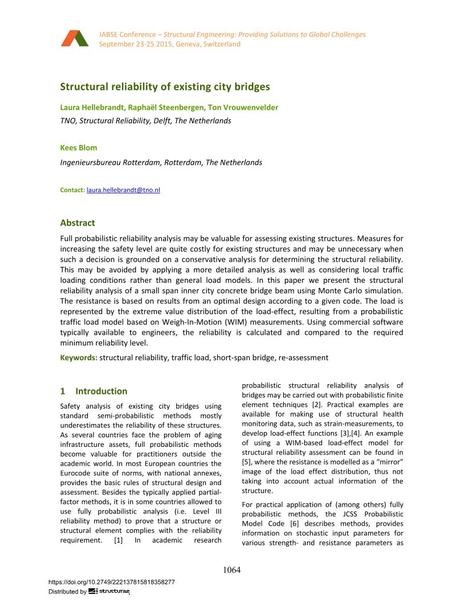Structural reliability of existing city bridges

|
|
|||||||||||
Détails bibliographiques
| Auteur(s): |
Laura Hellebrandt
(TNO, Structural Reliability, Delft, The Netherlands)
Raphaël Steenbergen (TNO, Structural Reliability, Delft, The Netherlands) Kees Blom (Ingenieursbureau Rotterdam, Rotterdam, The Netherlands) Ton Vrouwenvelder (TNO, Structural Reliability, Delft, The Netherlands) |
||||
|---|---|---|---|---|---|
| Médium: | papier de conférence | ||||
| Langue(s): | anglais | ||||
| Conférence: | IABSE Conference: Structural Engineering: Providing Solutions to Global Challenges, Geneva, Switzerland, September 2015 | ||||
| Publié dans: | IABSE Conference Geneva 2015 | ||||
|
|||||
| Page(s): | 1064-1071 | ||||
| Nombre total de pages (du PDF): | 8 | ||||
| Année: | 2015 | ||||
| DOI: | 10.2749/222137815818358277 | ||||
| Abstrait: |
Full probabilistic reliability analysis may be valuable for assessing existing structures. Measures for increasing the safety level are quite costly for existing structures and may be unnecessary when such a decision is grounded on a conservative analysis for determining the structural reliability. This may be avoided by applying a more detailed analysis as well as considering local traffic loading conditions rather than general load models. In this paper we present the structural reliability analysis of a small span inner city concrete bridge beam using Monte Carlo simulation. The resistance is based on results from an optimal design according to a given code. The load is represented by the extreme value distribution of the load-effect, resulting from a probabilistic traffic load model based on Weigh-In-Motion (WIM) measurements. Using commercial software typically available to engineers, the reliability is calculated and compared to the required minimum reliability level. |
||||
